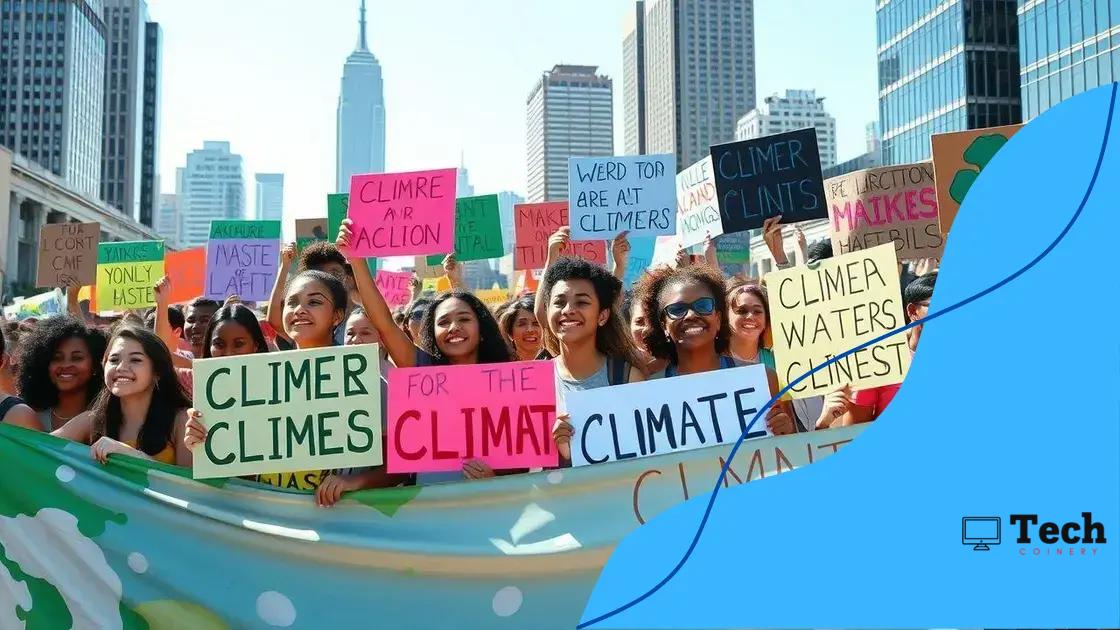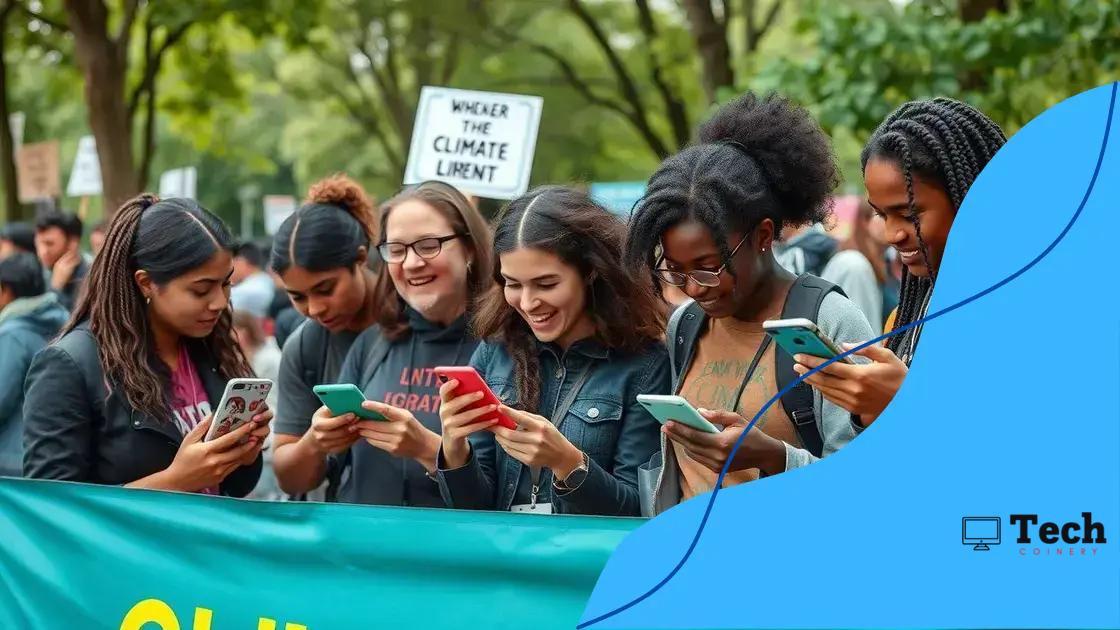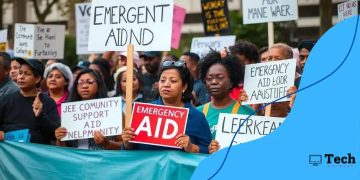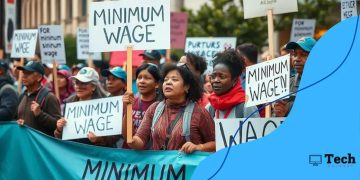Youth climate activism resurgence: a powerful wave

Youth climate activism is a powerful movement where young people advocate for urgent environmental action, using social media to mobilize support and influence policy changes for a sustainable future.
Youth climate activism resurgence is making waves across the globe, igniting conversations and inspiring change. Have you noticed how passionate the younger generations are about our planet? They are not just talking; they are taking action!
Understanding the roots of youth climate activism
Understanding the roots of youth climate activism is essential in grasping the energy and urgency behind today’s movements. Young people are stepping up to advocate for our planet, often driven by a sense of injustice and urgency. As we explore this topic, we will uncover the historical events, societal changes, and influential figures that sparked this powerful wave of activism.
The historical context
The modern youth climate movement gained momentum after significant environmental events. The 1970 Earth Day marked the beginning of global awareness on climate issues. However, it was the publication of major scientific reports, such as the Intergovernmental Panel on Climate Change (IPCC), that truly highlighted the looming threats of climate change.
Key figures inspiring change
Several young leaders have emerged, driving the conversation forward. Figures such as Greta Thunberg, who began striking from school to protest inaction on climate change, have become symbols for youth activism worldwide. Inspired by personal stories and the desire for a better future, these leaders galvanize their peers to take action.
- Greta Thunberg’s school strikes and speeches
- Formation of organizations like Fridays for Future
- Global protests initiated and led by young activists
Education plays a crucial role in shaping the consciousness of young activists. Schools and universities have begun integrating climate education into their curricula. This commitment fosters a generation that is well-informed about climate issues and equipped to advocate for sustainable solutions.
The role of social movements
Social movements have propelled the message of youth activism far beyond local communities. Online platforms have provided avenues for organizing and spreading awareness rapidly. Campaigns and hashtags, such as #ClimateStrike, have united millions of students in their cause.
The intersection of climate justice with social justice is also pivotal. Young activists recognize that climate change disproportionately affects marginalized communities. This realization deepens their commitment to advocate not just for the environment, but also for equitable solutions across the globe.
As the youth continue to rally and mobilize, understanding these roots lays the groundwork for recognizing their impact and potential for growth. This activism isn’t just a trend; it is a fundamental shift in how we, as a collective society, view our responsibility towards the planet and each other.
Key figures and movements in today’s activism
Key figures and movements in today’s activism play a vital role in shaping the landscape of youth climate activism. These leaders and groups not only raise awareness but also inspire action across the globe. Their passion and dedication invigorate the fight against climate change, mobilizing young activists everywhere.
Influential leaders
Among the most notable figures is Greta Thunberg, who has become the face of youth climate activism. Her school strike movement, started in August 2018, quickly spread worldwide. Greta’s speeches, filled with urgency, challenge leaders to take decisive action. She emphasizes the need for immediate change, capturing the attention of millions.
Notable movements
Several important movements have emerged from this wave of activism, including Fridays for Future and Sunrise Movement. Fridays for Future has organized global climate strikes, bringing students together to demand action from political leaders. This movement showcases the power of young voices, as demonstrated through their massive gatherings.
- Fridays for Future mobilizes millions of students worldwide.
- Sunrise Movement focuses on a Green New Deal in the United States.
- Extinction Rebellion promotes non-violent civil disobedience.
The impact of these movements extends far beyond protests. They have sparked conversations in schools, communities, and even governments. The youth’s passion drives initiatives for sustainable policies and reforms that aim to combat climate change effectively.
Collaborative efforts
Collaboration is key for these movements. Young activists are joining forces with organizations, creating a united front to advocate for change. Through social media, they share resources and experiences, amplifying their collective voice. This synergy enhances their impact, making it clear that youth activism is not a solitary effort.
The diversity among leaders and movements enriches the narrative of youth climate activism. From indigenous rights to social justice, the intersectionality of these issues is at the forefront of today’s climate discussions. Understanding the roles of these key figures and movements allows us to appreciate the complexity and depth of the activism landscape.
The role of social media in youth mobilization

The role of social media in youth mobilization has transformed the way activists connect and organize. Platforms like Twitter, Instagram, and TikTok serve as powerful tools for spreading awareness and igniting action among young people. Social media not only amplifies voices but also creates communities united by a common cause.
Connecting with the audience
Through engaging posts and impactful visuals, activists can reach vast audiences. Posts that resonate emotionally often go viral, spreading important messages quickly. Sharing personal stories, especially from young activists, can touch hearts and inspire others to take part in the movement.
Creating online communities
Online networks foster collaboration among youth activists, allowing them to share resources and strategies. Facebook groups, Discord channels, and hashtag campaigns unite individuals from different backgrounds. By sharing tools and tactics, they create a stronger collective force.
- Hashtags like #FridaysForFuture and #ClimateStrike unify activists globally.
- Events can be organized efficiently through social media announcements.
- Real-time updates keep activists informed about protests and initiatives.
Many organizations use social media to promote educational campaigns. They create content that teaches followers about environmental issues and climate justice. This education empowers young people to speak out with confidence and knowledge. The more informed they are, the more effective their advocacy becomes.
Challenges faced
While social media offers advantages, it also presents challenges. Misinformation can spread just as quickly as accurate information. Young activists must learn to discern credible sources to avoid confusion. Additionally, online harassment can dissuade some from speaking out. Thus, creating a supportive online environment is essential.
Despite these challenges, the impact of social media on youth mobilization is undeniable. Activists harness technology to build movements, share their stories, and influence change. By bridging the gap between local and global issues, they inspire action among their peers and encourage a worldwide dialogue about climate change.
Impacts of youth activism on policy changes
The impacts of youth activism on policy changes are significant and far-reaching. Young people are increasingly challenging political leaders and demanding action on climate change. Their voices push for reforms that address social and environmental injustices, leading to real changes in policy.
Shaping public discourse
Through activism, youth bring attention to issues that may have been overlooked. By organizing protests and speaking at public events, they shape the conversation around climate policy. Their passionate advocacy helps to create urgency among lawmakers to implement solutions.
Successful campaigns
Many youth-led campaigns have directly influenced policy decisions. For instance, the Climate Strikes initiated by activists like Greta Thunberg led to substantial public discussions on climate action. These strikes have rallied millions around the globe, making climate issues impossible to ignore.
- Increased youth participation in local government decision-making.
- Success in securing commitments from various countries to reduce carbon emissions.
- Raising awareness about the need for just policies that protect vulnerable communities.
Youth activists have also engaged with officials through formal channels, leading to policy proposals that align with their demands. For example, some cities have implemented Green New Deal-like initiatives due to pressure from young activists. These initiatives focus on sustainability and creating green jobs, showing that youth-driven movements can lead to substantial policy transformations.
Changing the narrative
The climate crisis narrative is evolving thanks to youth activism. By spotlighting the connection between climate change and social justice, they advocate for policies that protect not only the environment but also marginalized communities. This intersectional approach creates a comprehensive framework for understanding and addressing climate issues.
As young activists continue to rally support and mobilize their communities, their influence on policy is undeniable. They are not just shaping the future of environmental policy; they are redefining what is possible in politics today. Their voices ensure that the needs of future generations are not ignored in the decision-making processes.
Future of climate activism and youth engagement
The future of climate activism and youth engagement holds great promise as a new generation rises to tackle pressing environmental issues. Young activists continue to innovate and adapt their strategies, ensuring that their voices remain influential in shaping climate policy and action.
Emerging trends
One significant trend is the use of technology to enhance activism. Platforms like TikTok and Instagram allow for creative expression and broad outreach. Activists use these tools to share compelling stories, educate peers, and mobilize support for environmental causes.
Collaboration across generations
The collaboration between youth and older generations is also critical for effective climate action. By learning from previous activists, young people can combine experience with fresh ideas. This partnership can lead to innovative solutions and strengthen movement unity.
- Younger activists learn strategies from seasoned leaders.
- Intergenerational dialogues foster mutual understanding.
- Collaborative projects can amplify impact and resources.
Furthermore, youth engagement is evolving to include diverse voices. Activists are advocating for intersectionality, recognizing that issues like race, gender, and class significantly influence environmental challenges. Movements that embrace diversity tend to be more resilient and impactful.
Policy advocacy and grassroots movements
As climate issues become more urgent, youth are increasingly involved in policy advocacy. They demand action from leaders and work tirelessly to promote sustainable legislation. Grassroots movements are also growing, with local initiatives springing up to tackle community-specific environmental challenges.
These movements engage communities directly and empower individuals to take part in climate action. By focusing on local issues, young activists can create tailored solutions that resonate with their communities, making activism more relevant and effective.
Looking ahead, the energy and determination of young activists will continue to influence the fight against climate change. Their commitment to sustainability and justice will shape policies, create awareness, and promote positive environmental change. As new challenges arise, youth will rise to the occasion, driving the movement forward with their inventive ideas and resolute spirit.
Youth climate activism is shaping the future in powerful ways. As young people continue to advocate for change, their actions inspire others and influence policy. They harness social media to spread awareness, build communities, and create movements that demand urgent action. The collaboration between young and older generations strengthens the fight against climate change, incorporating diverse voices for a more equitable future. Together, they will drive innovation and ensure that environmental issues remain a priority for governments worldwide.
FAQ – Frequently Asked Questions About Youth Climate Activism
What is youth climate activism?
Youth climate activism refers to the efforts of young people advocating for urgent action on climate change and environmental issues.
How does social media impact youth activism?
Social media allows young activists to connect, share their messages widely, and mobilize supporters quickly for climate actions.
Who are some key figures in youth climate activism?
Notable figures include Greta Thunberg and various leaders from organizations like Fridays for Future, who inspire global movements.
What role do young activists play in policy changes?
Young activists influence policy by advocating for sustainable practices, demanding accountability from leaders, and pushing for new environmental legislation.






